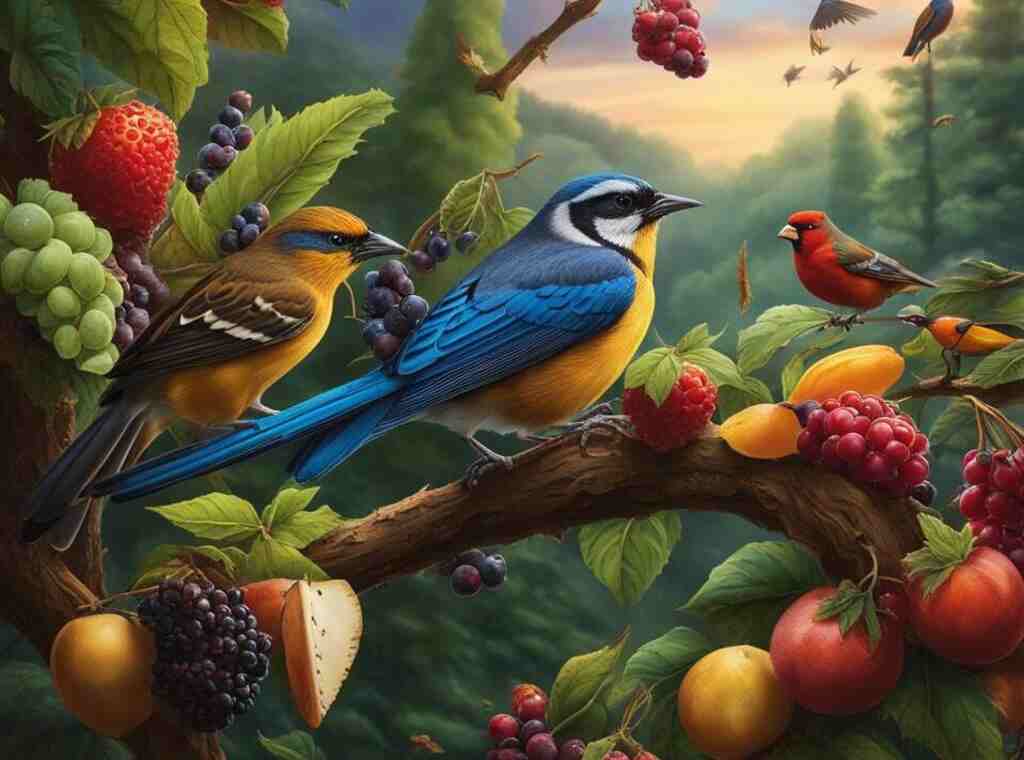Birds are fascinating creatures, known for their diverse eating habits and feeding behaviors. While it may seem like birds are always hungry, their feeding patterns are influenced by various factors, including satiety levels, hunger cues, and nutritional needs.
In this article, I will delve into the intriguing world of bird feeding behavior, shedding light on the factors that affect their appetite and offering insights into their hunger cues and satiety signals.
Understanding why birds eat the way they do is crucial for providing them with proper nutrition and ensuring their wellbeing.
Table of Contents
- 1 Key Takeaways:
- 2 Are Birds Always Hungry?
- 3 Understanding a Bird’s Need to Feed
- 4 Decoding Avian Hunger Cues and Satiety Signals
- 5 Bird Foraging Behavior and Dietary Preferences
- 6 The Impact of Environment and Health on Bird Feeding Habits
- 7 A Deeper Dive into Pigeon Feeding Patterns
- 8 Conclusion
- 9 FAQs:
- 9.1 Are birds always hungry?
- 9.2 What factors affect a bird’s appetite?
- 9.3 How do birds communicate their hunger levels?
- 9.4 What are some dietary preferences of birds?
- 9.5 How does physical activity affect a bird’s appetite?
- 9.6 What are some feeding patterns of urban pigeons?
- 9.7 How can we support the nutritional needs of birds?
- 10 Source Links
- 11 Author
Key Takeaways:
- Birds have unique feeding patterns influenced by their nutritional needs and satiety levels.
- Hunger cues in birds play an important role in regulating their appetite and feeding frequency.
- Factors like avian hunger triggers and satiety signals affect a bird’s feeding behavior.
- Properly understanding bird eating habits helps to support their nutritional requirements.
- Providing suitable food sources is essential for maintaining bird health and habitat preservation.
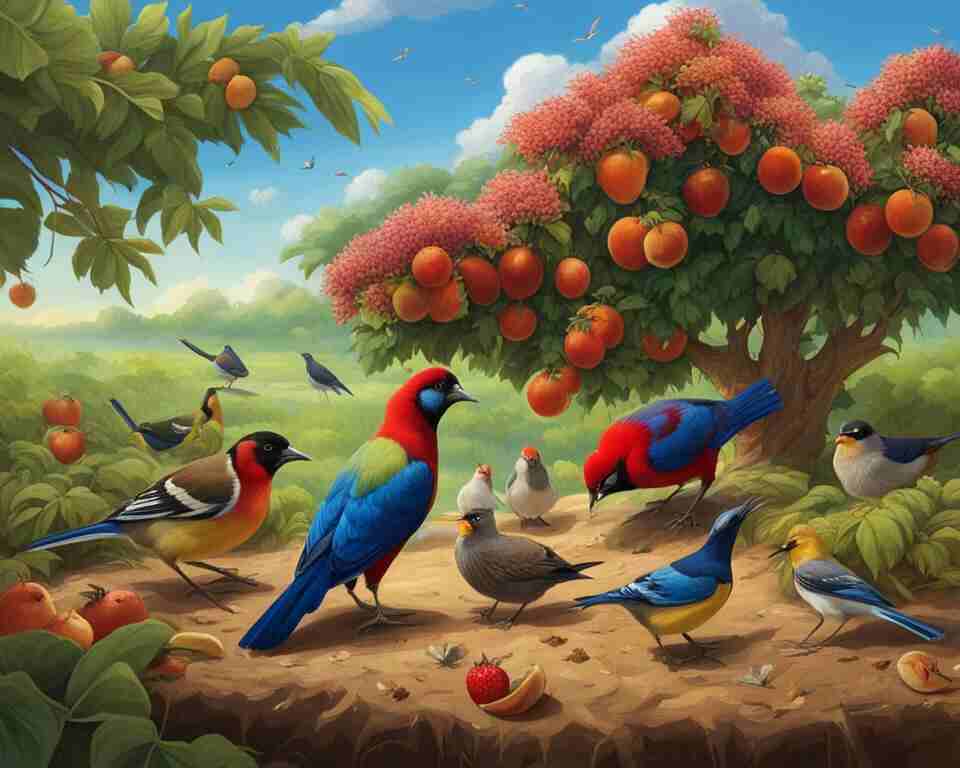
Are Birds Always Hungry?
While birds have a natural drive to seek out food, it does not mean that they are always hungry. The level of hunger in birds can vary depending on individual needs and environmental conditions. Factors such as overall health, recent meals, and physical activity levels can affect a bird’s hunger level.
It is important to understand that birds naturally forage for food and may constantly be on the lookout for new food sources, but it does not necessarily mean that they are always hungry.
In order to maintain their energy levels and meet their nutritional needs, birds have evolved to eat frequently. This constant need for food is part of their survival strategy and ensures they have enough energy to perform essential activities such as flying, building nests, and breeding.
However, birds also have mechanisms in place to regulate their appetite and hunger cues. Their hunger patterns are influenced by factors such as food availability, seasonality, and fasting during migration.
Additionally, a bird’s overall health plays a significant role in its hunger patterns. A healthy bird that receives a balanced diet will have its nutritional needs met, leading to a more regulated appetite.
On the other hand, an unhealthy or malnourished bird may exhibit increased hunger as its body seeks to acquire the necessary nutrients.
Physical activity levels also impact a bird’s hunger. Birds that are more active, such as those engaged in territorial disputes, courtship displays, or foraging long distances, may require more frequent meals to sustain their energy expenditure.
Overall, while birds have a constant need to find food, they experience variations in their hunger levels. Factors such as health, recent meals, and physical activity directly influence a bird’s appetite and feeding frequency.
By understanding these dynamics, we can better support birds’ nutritional needs and appreciate their natural foraging behavior.
Understanding a Bird’s Need to Feed
In order to understand a bird’s feeding behavior, it is important to consider various factors that influence their appetite and hunger patterns. Birds, such as pigeons, have an innate drive to seek out food for survival, which contributes to their constant search for sustenance.
Pigeons: Innate Drive and High Metabolism
Pigeons, known for their ubiquitous presence in urban areas, possess a natural instinct to forage for food. This innate drive stems from their need to meet their nutritional requirements and maintain their energy levels. Pigeons’ high metabolism requires them to consume food frequently in order to sustain their bodily functions.
The Role of Resting Metabolic Rate in Bird Hunger
Resting metabolic rate, which refers to the amount of energy expended by a bird at rest, is closely tied to its hunger levels. Birds with a higher resting metabolic rate tend to experience more frequent hunger cues and have a greater need for food consumption. This continuous energy expenditure emphasizes the importance of regular feeding in avian species.
Factors That Affect a Bird’s Appetite
A bird’s appetite and feeding behavior can be influenced by various factors. Age, health, and activity levels can all play a role in determining the frequency and quantity of food a bird consumes.
Additionally, environmental conditions, availability of food sources, and the presence of stressors can impact a bird’s appetite and satiation levels.
In conclusion, understanding a bird’s need to feed requires consideration of their innate drive for survival, the influence of resting metabolic rate on hunger levels, and the various factors that affect their appetite.
By comprehending these aspects of bird feeding behavior, we can better support their nutritional needs and contribute to their overall well-being.
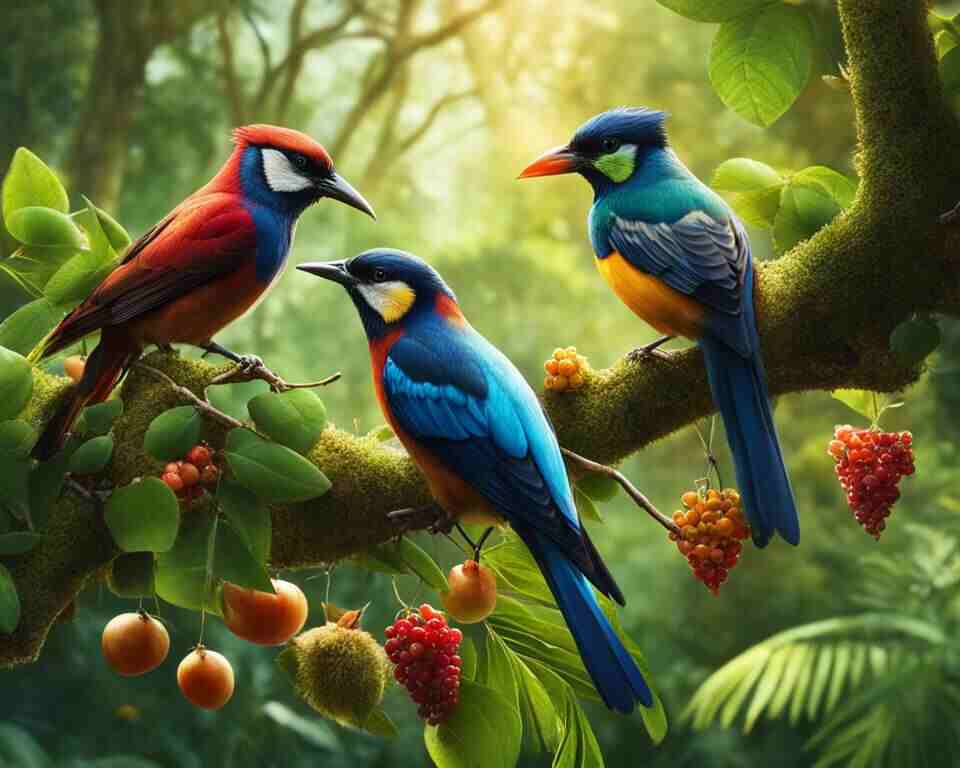
Decoding Avian Hunger Cues and Satiety Signals
Birds have unique ways of communicating their hunger levels, primarily through body language and vocalizations. Understanding these hunger cues and satiety signals is essential in ensuring that birds’ nutritional needs are met and their overall health is maintained.
Interpreting Birds’ Body Language and Vocalizations
Observing a bird’s body language can provide valuable insights into its hunger level. For example, flapping wings, restlessness, and frequent hopping from branch to branch may indicate that a bird is actively searching for food.
On the other hand, if a bird appears calm, relaxed, and preens its feathers, it may be a sign of satisfaction and satiety.
Vocalizations also play a crucial role in avian communication. Some birds emit low-pitched calls when hungry, while others produce high-pitched chirps to establish their territorial boundaries and signal their satisfaction after a meal.
By paying attention to these vocal cues, bird enthusiasts can better understand the hunger levels and feeding needs of the birds they encounter.
Connection Between Stress and Feeding Patterns in Birds
Stress can significantly impact a bird’s feeding patterns, leading to changes in appetite and behavior. Factors such as predation threats, changes in habitat or food availability, and disturbances from human activities can induce stress responses in birds.
These stressors may cause birds to alter their feeding habits, either by increasing or decreasing their food intake. Recognizing signs of stress in birds and addressing the underlying factors can help restore normal feeding patterns and maintain their overall well-being.
Identifying Hunger vs. Satisfaction in Avian Feeding Behavior
Differentiating between hunger and satisfaction in bird feeding behavior can be challenging but is crucial to ensure that a bird’s nutritional needs are met. It’s important to consider factors such as the bird’s species, age, and general health when assessing its feeding behavior.
Monitoring the frequency and intensity of feeding sessions, as well as changes in eating patterns, can provide valuable insights into a bird’s hunger level. Additionally, observing the bird’s response to food offerings, such as eagerly consuming the food or losing interest quickly, can help determine its level of satisfaction.
To maintain bird health, it is essential to understand and respond to their hunger cues accurately. By interpreting their body language, vocalizations, and considering the impact of stress on their feeding patterns, we can ensure that birds receive the necessary nutrition for their well-being.
Bird Foraging Behavior and Dietary Preferences
Birds exhibit unique foraging tendencies and have specific dietary requirements. Different bird species have evolved distinct beak shapes and sizes to find and consume specific types of food.
By understanding a bird’s foraging behavior and dietary preferences, we can provide them with a suitable and balanced diet that meets their nutritional needs.
For example, birds with long, slender beaks are adapted to extract nectar from flowers, while those with strong, hooked beaks are specialized for tearing into flesh. Some birds, like finches, prefer seeds and grains, while others, such as hummingbirds, rely on a diet rich in nectar.
By observing the natural feeding habits of different bird species, we can replicate their diets in captivity or provide suitable food sources in our gardens and natural habitats. This can help attract a diverse range of bird species and contribute to their overall well-being.
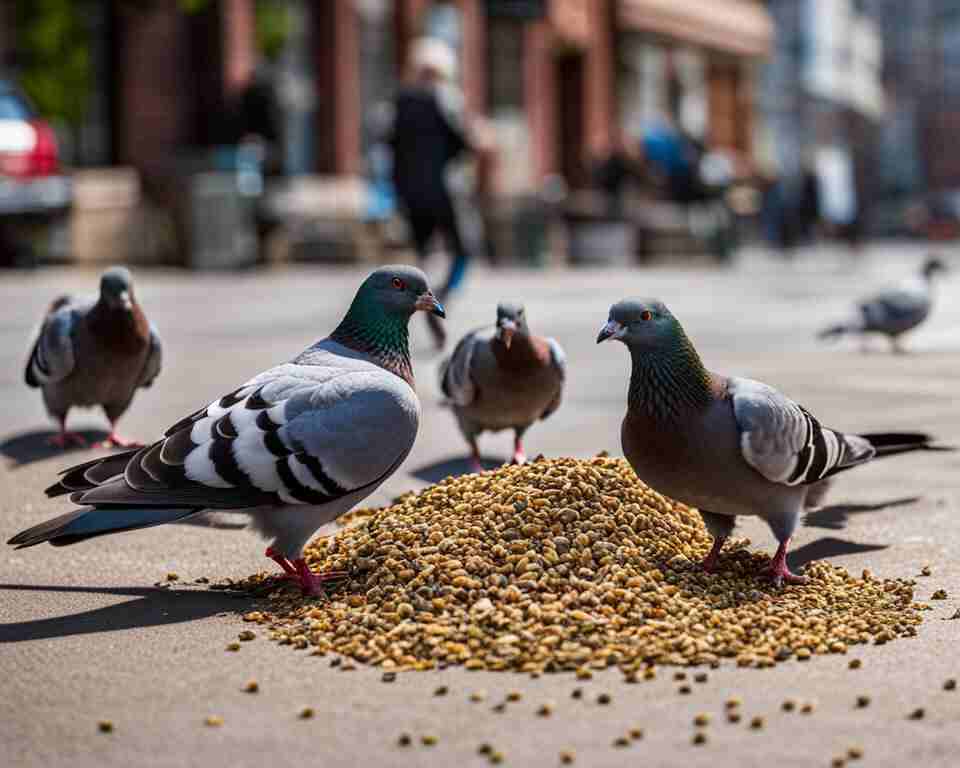
The Impact of Environment and Health on Bird Feeding Habits
Understanding the impact of the environment and health on bird feeding habits is crucial for providing optimal care and support to our feathered friends.
Several factors, such as physical activity levels, adaptation to different food sources, and the availability of water, play significant roles in shaping bird feeding behaviors and meeting their nutritional needs.
How Physical Activity and Health Influence Appetite
Physical activity and overall health directly affect a bird’s appetite and feeding habits. Birds that engage in more physical activity have higher energy requirements and need to eat more frequently.
Birds with an active lifestyle, such as those that fly long distances or engage in complex foraging behaviors, burn more calories and have a greater need for food to sustain their energy levels.
In contrast, birds with reduced physical activity, such as those that are injured or recovering from illness, may have a decreased appetite.
In these cases, it’s essential to provide easily digestible and nutrient-rich food options to support their recovery and ensure optimal health.
Adapting to Urban and Natural Food Sources
Birds are remarkably adaptable and can adjust their feeding habits based on the availability of food sources in their environment. In urban areas, birds often rely on human-provided food sources, such as bird feeders, scraps, or leftover food.
They have learned to take advantage of these readily available resources, which influence their feeding patterns and preferences.
In natural environments, birds forage for a variety of food sources, including insects, seeds, fruits, and nectar. Their feeding behavior is shaped by both instinct and learning, with different species having specific dietary preferences based on their beak shape and size.
Understanding a bird’s natural feeding behavior is crucial for providing them with suitable food options that meet their specific nutritional needs.
The Availability of Water and its Role in Feeding Frequency
Water plays a vital role in bird feeding habits, as it impacts their feeding frequency and behavior. Birds require water for digestion, hydration, and maintaining their overall health.
The availability of clean, fresh water sources in their environment is crucial for attracting birds and encouraging them to visit and feed regularly.
When water sources are scarce or unavailable, birds may reduce their feeding frequency, as they rely on water to process and digest their food.
Providing water sources, such as bird baths or shallow dishes, not only supports birds’ hydration needs but also enhances their feeding habits, ensuring they have the necessary resources for optimal health and wellbeing.
| Factors | Impact on Bird Feeding Habits |
|---|---|
| Physical Activity and Health | Affects appetite and feeding frequency. More active birds have higher energy requirements. |
| Adaptation to Environment | Birds adjust their feeding habits based on food availability in their surroundings. |
| Availability of Water | Influences feeding frequency and digestion. Adequate water sources are essential for bird health. |
A Deeper Dive into Pigeon Feeding Patterns
Pigeons, being common urban birds, have specific feeding patterns and dietary habits. Understanding their feeding behavior can provide insights into their nutritional needs and how to support them.
Nesting, Foraging, and The Daily Diet of Urban Pigeons
Urban pigeons rely on various food sources for their daily diet. They have adapted to scavenge for food in urban environments, including parks, streets, and buildings.
Pigeons often feed on discarded food from humans, such as bread crumbs, leftover fast food, and other edible scraps. They may also rely on bird feeders or seeds provided by bird enthusiasts.
Pigeons exhibit both grazing and flock feeding behaviors. They are capable of consuming a significant amount of food, particularly when ample food sources are available. Pigeons have a relatively large crop, which allows them to store and process food efficiently.
Their diet consists of a variety of grains, seeds, fruits, vegetables, and small insects. While they primarily feed on plant-based foods, pigeons are known to occasionally eat insects as a source of protein.
Understanding the Impact of Easy Access to Food
The easy access to food in urban areas can influence pigeons’ feeding patterns. When food is readily available, pigeons may spend less time foraging and engage in other behaviors such as preening, socializing, or resting. This can lead to increased population densities in urban areas where food is abundant.
However, easy access to food can also result in overconsumption, leading to potential health issues. Pigeons may become dependent on human-provided food sources and their natural foraging instincts may diminish.
It is important to strike a balance by providing suitable and varied food sources while allowing pigeons to maintain their natural foraging behavior.
Feeding Needs Across Different Pigeon Life Stages
Pigeon feeding needs can vary depending on different life stages. During nesting and breeding periods, pigeons require a higher intake of nutrients to support the growth and development of their young.
It is essential to provide an adequate supply of food during these critical stages to ensure the health and success of the nesting pairs and their offspring.
Molting is another important phase in a pigeon’s life when adequate nutrition is crucial. Molting refers to the process of shedding old feathers and growing new ones.
This requires a substantial amount of energy and nutrients. Proper nutrition during molting can ensure the production of healthy feathers and support the overall well-being of the pigeon.
| Pigeon Feeding Patterns | Feeding Factors |
|---|---|
| Grazing behavior | Eating small amounts of food throughout the day |
| Flock feeding behavior | Gathering together in groups to feed |
| Plant-based diet | Feeding on grains, seeds, fruits, and vegetables |
| Insect consumption | Occasional intake of insects for protein |
Conclusion
Understanding the feeding behavior of birds carries significant implications for bird health and the preservation of their habitats. By providing suitable food sources and maintaining their environments, we can effectively support their nutritional needs and overall well-being.
It is crucial to recognize that our relationship with birds can be enhanced by gaining a deeper understanding of their feeding behavior and nutritional requirements, leading to increased appreciation and conservation efforts.
In conclusion, the key takeaways from this exploration of bird feeding behavior include the importance of offering a balanced diet, accurately interpreting hunger cues, and ensuring access to an adequate supply of food and water for birds.
Providing a diverse range of food sources and considering factors such as age, health, and activity levels can contribute to the optimal health and happiness of our feathered friends.
To further promote bird health and habitat preservation, ongoing research and education are essential. By supporting scientific endeavors and increasing awareness of the critical role birds play in our ecosystems, we can take significant steps towards creating a sustainable future for both birds and humans.
Let us embrace the opportunity to cultivate a harmonious and mutually beneficial relationship with these magnificent creatures by appreciating and safeguarding their nutritional needs and natural habitats.
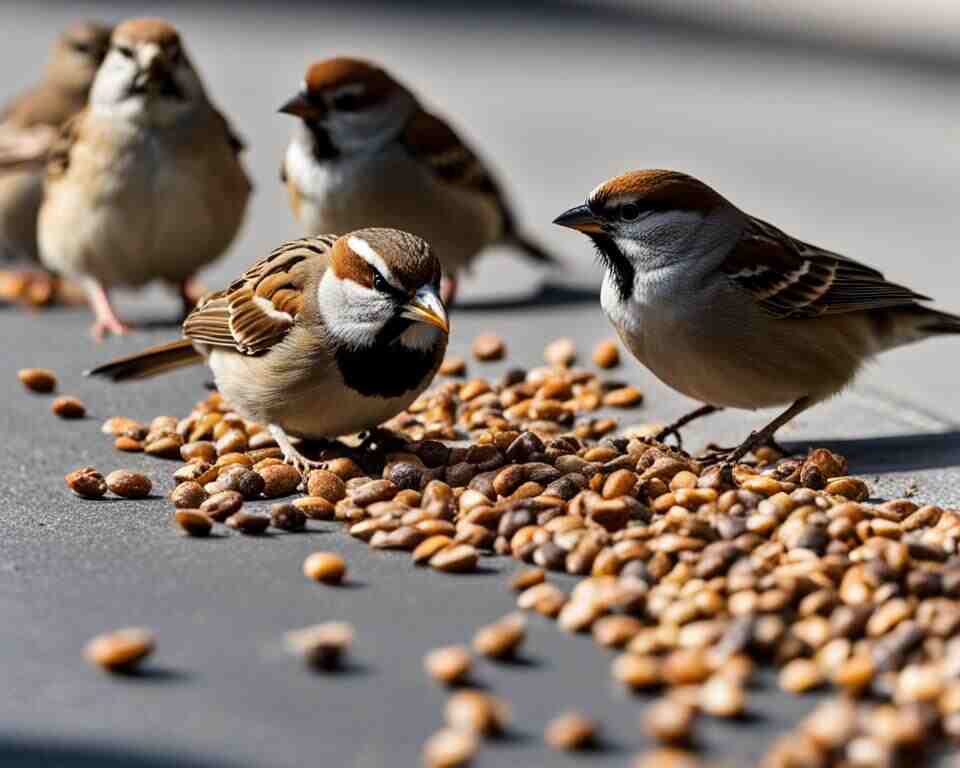
FAQs:
Are birds always hungry?
While birds have a natural drive to seek out food and forage for it, it doesn’t necessarily mean they are always hungry. Factors such as individual needs, overall health, recent meals, and physical activity levels can affect a bird’s hunger level.
What factors affect a bird’s appetite?
Various factors can affect a bird’s appetite and feeding behavior, including age, health, and activity levels. Additionally, stress can impact a bird’s feeding patterns, leading to changes in appetite and behavior.
How do birds communicate their hunger levels?
Birds communicate their hunger levels through body language and vocalizations. By understanding these cues, we can determine if a bird is hungry or satisfied.
What are some dietary preferences of birds?
Different bird species have evolved to find and consume specific types of food, influenced by factors such as beak shape and size. Understanding a bird’s foraging behavior and dietary preferences can help provide them with a suitable and balanced diet.
How does physical activity affect a bird’s appetite?
Physical activity and overall health can influence a bird’s appetite and feeding habits. Birds that are more active may have higher energy requirements and need to eat more frequently.
What are some feeding patterns of urban pigeons?
Urban pigeons rely on various food sources, including discarded food and bird feeders. Their feeding needs can vary depending on nesting, foraging, and different life stages such as breeding or molting.
How can we support the nutritional needs of birds?
Supporting the nutritional needs of birds involves providing a balanced diet, interpreting hunger cues, and ensuring access to food and water. By understanding bird feeding behavior, we can help maintain bird health and contribute to habitat preservation.

